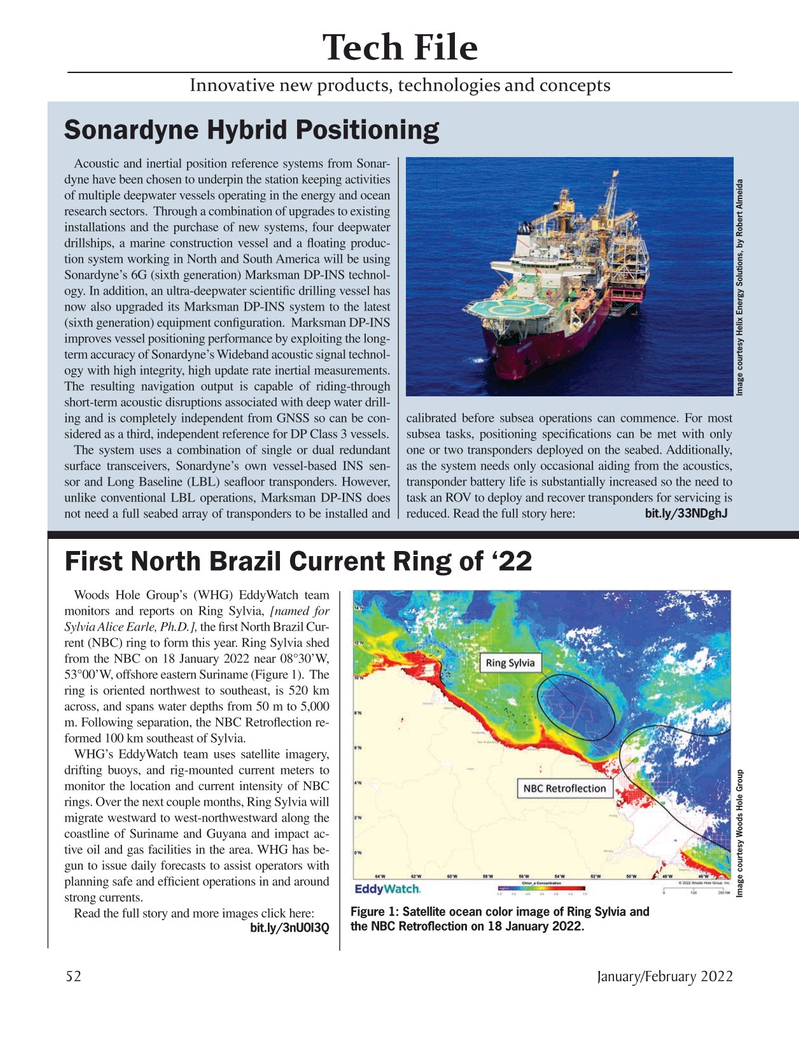
Page 52: of Marine Technology Magazine (January 2022)
Read this page in Pdf, Flash or Html5 edition of January 2022 Marine Technology Magazine
Tech File
Innovative new products, technologies and concepts
Sonardyne Hybrid Positioning
Acoustic and inertial position reference systems from Sonar- dyne have been chosen to underpin the station keeping activities of multiple deepwater vessels operating in the energy and ocean research sectors. Through a combination of upgrades to existing installations and the purchase of new systems, four deepwater drillships, a marine construction vessel and a ? oating produc- tion system working in North and South America will be using
Sonardyne’s 6G (sixth generation) Marksman DP-INS technol- ogy. In addition, an ultra-deepwater scienti? c drilling vessel has now also upgraded its Marksman DP-INS system to the latest (sixth generation) equipment con? guration. Marksman DP-INS improves vessel positioning performance by exploiting the long- term accuracy of Sonardyne’s Wideband acoustic signal technol- ogy with high integrity, high update rate inertial measurements.
The resulting navigation output is capable of riding-through short-term acoustic disruptions associated with deep water drill- ing and is completely independent from GNSS so can be con- calibrated before subsea operations can commence. For most sidered as a third, independent reference for DP Class 3 vessels. subsea tasks, positioning speci? cations can be met with only
The system uses a combination of single or dual redundant one or two transponders deployed on the seabed. Additionally, surface transceivers, Sonardyne’s own vessel-based INS sen- as the system needs only occasional aiding from the acoustics, sor and Long Baseline (LBL) sea? oor transponders. However, transponder battery life is substantially increased so the need to unlike conventional LBL operations, Marksman DP-INS does task an ROV to deploy and recover transponders for servicing is bit.ly/33NDghJ not need a full seabed array of transponders to be installed and reduced. Read the full story here:
First North Brazil Current Ring of ‘22
Woods Hole Group’s (WHG) EddyWatch team monitors and reports on Ring Sylvia, [named for
Sylvia Alice Earle, Ph.D.], the ? rst North Brazil Cur- rent (NBC) ring to form this year. Ring Sylvia shed from the NBC on 18 January 2022 near 08°30’W, 53°00’W, offshore eastern Suriname (Figure 1). The ring is oriented northwest to southeast, is 520 km across, and spans water depths from 50 m to 5,000 m. Following separation, the NBC Retro? ection re- formed 100 km southeast of Sylvia.
WHG’s EddyWatch team uses satellite imagery, drifting buoys, and rig-mounted current meters to monitor the location and current intensity of NBC rings. Over the next couple months, Ring Sylvia will migrate westward to west-northwestward along the coastline of Suriname and Guyana and impact ac- tive oil and gas facilities in the area. WHG has be- gun to issue daily forecasts to assist operators with planning safe and ef? cient operations in and around
Image courtesy Woods Hole Group Image courtesy Helix Energy Solutions, by Robert Almeida strong currents.
Figure 1: Satellite ocean color image of Ring Sylvia and
Read the full story and more images click here: the NBC Retro? ection on 18 January 2022. bit.ly/3nU0I3Q 52 January/February 2022
MTR #1 (50-63).indd 52 1/25/2022 8:49:16 AM

 51
51

 53
53
